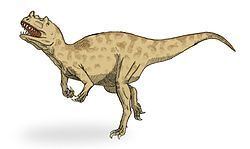Kingdom Animalia Clade Dinosauria Suborder Theropoda Higher classification Theropods | Phylum Chordata Order Saurischia Clade †Neoceratosauria Rank Family | |
 | ||
Similar Theropods, Dinosaur, Ceratosaurus, Compsognathidae, Megalosauridae | ||
Ceratosauridae is a family of theropod dinosaurs belonging to the infraorder Ceratosauria. The family's type genus, Ceratosaurus, was first found in Jurassic rocks from North America. Ceratosauridae is made up of the genera Ceratosaurus, found in North America, Tanzania, and Portugal, Genyodectes, from the Late Cretaceous of Argentina, and Fosterovenator which is exclusive to North America. Unnamed probable ceratosaurids are known from limited material in the Middle Jurassic of Madagascar, the Late Jurassic of Switzerland, and the Late Jurassic or possibly Early Cretaceous of Uruguay.
Contents
Classification
Othniel Charles Marsh named the family Ceratosauridae in 1884 to contain the type species, Ceratosaurus nasicornis. Since then, a number of other species have been referred to this family, mainly from the genus Ceratosaurus. Currently recognized ceratosaurid species include C. dentisulcatus, C. magnicornis, and Genyodectes serus. C. stechowi is an undiagnostic ceratosaur. Fosterovenator churei was described in 2014 from material found at Como Bluff, Wyoming, and has also been assigned to this family. No cladistic definition of Ceratosauridae has been proposed.
Features
Due to the paucity of remains of Genyodectes, it is difficult to discern possible synapomorphies of the group from autapomorphies of Ceratosaurus; e.g. Ceratosaurus is different from other ceratosaurians by the very prominent horn on its snout; Genyodectes, however, was not found with a complete skull; whether it had a horn is unknown, so it cannot establish that the horn was a shared derived feature of the group.
There are two known types of Ceratosaurus teeth: one with longitudinal ridges and the other with smooth enamel. Both types of teeth have crowns with a teardrop-shaped cross section and carinae running up the middle. The cross section of the tooth's base depends on the position of the tooth in the mouth with front teeth having less symmetric cross sections.
Environment
Being found in the Morrison and Tendaguru put the Ceratosauridae family in the presence of other large predators. In North America, it is likely that members of the family such as C. nasicornis competed with allosaurs (A. fragilis) for food, such as sauropods common to the region at the time. In Africa and Europe members also competed with other large predators for similar food sources. The presence of C. nasicornis at the Cleveland Lloyd Dinosaur Quarry along with the remains of several allosaurids is a good indication of just how close members of this family and other predators coexisted.
Sites containing ceratosaurids
Note: Dry Mesa Quarry and Cleveland Lloyd Dinosaur Quarry are part of the Morrison Formation
